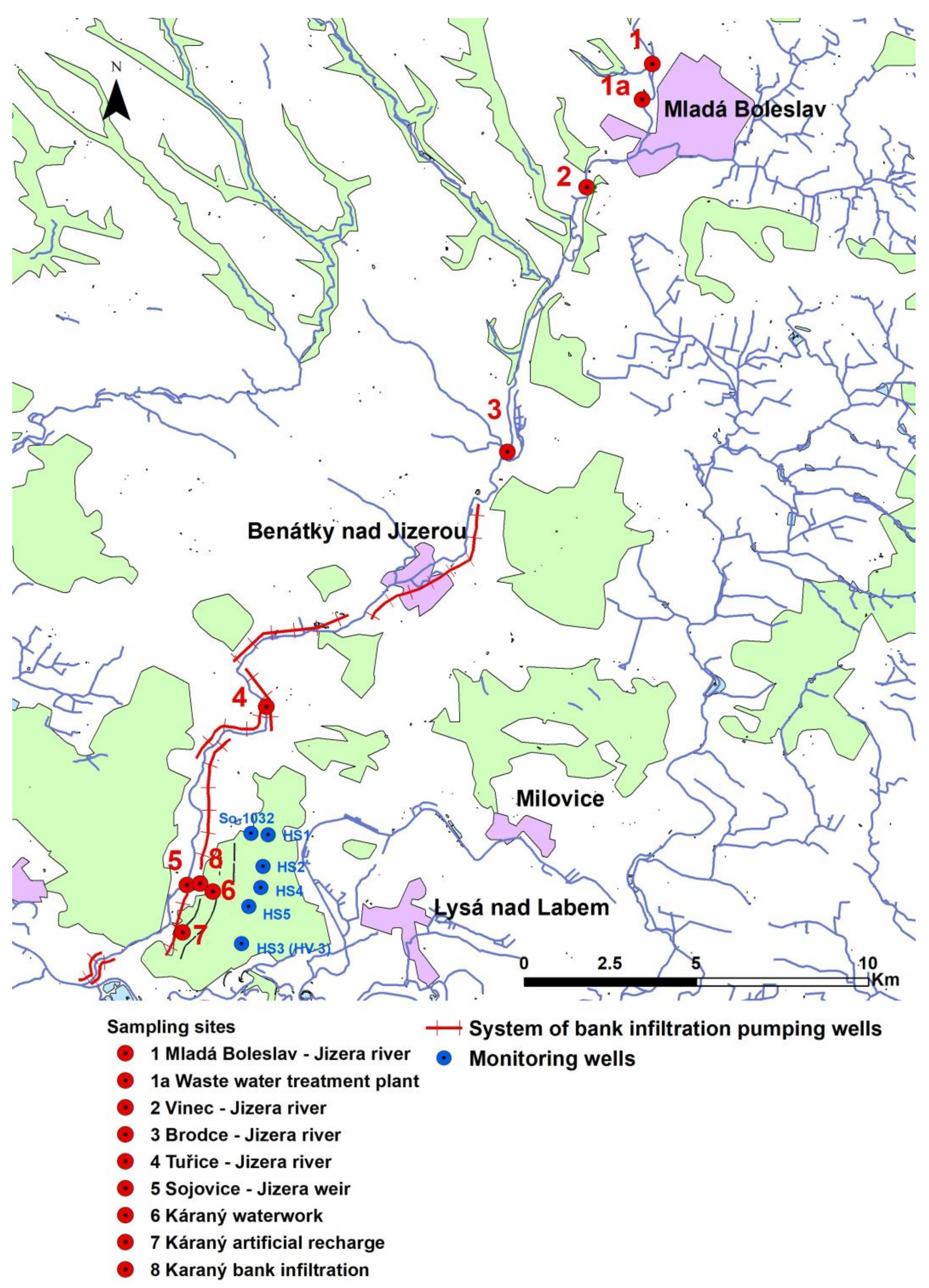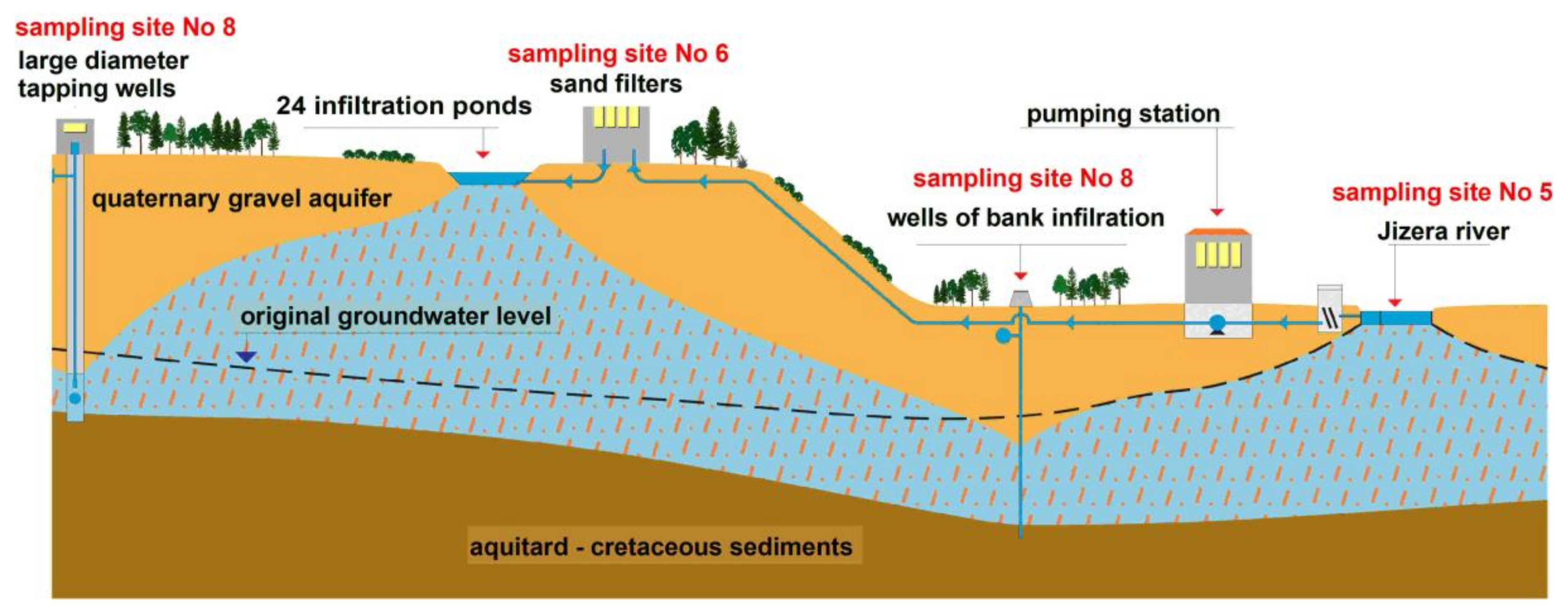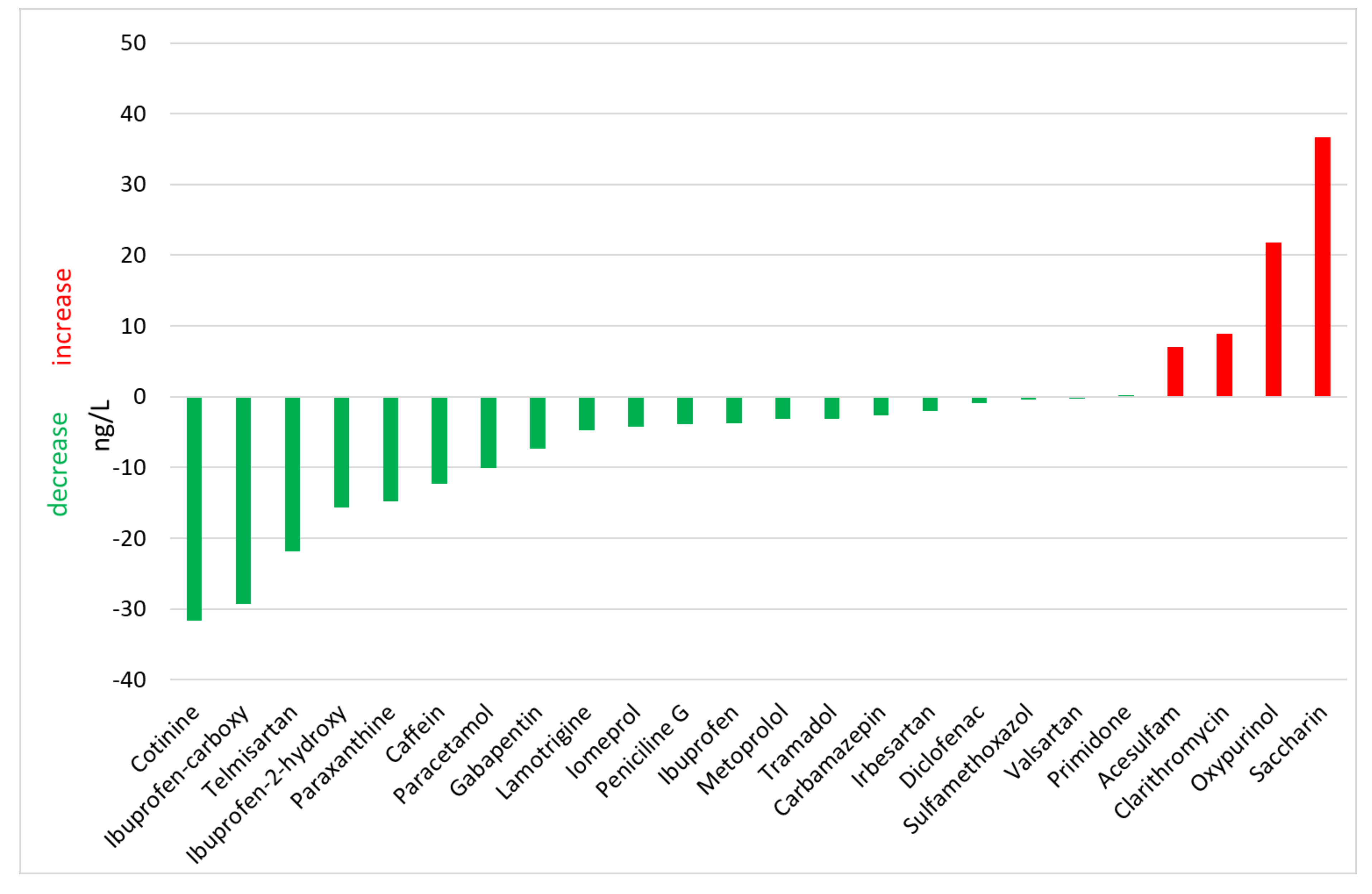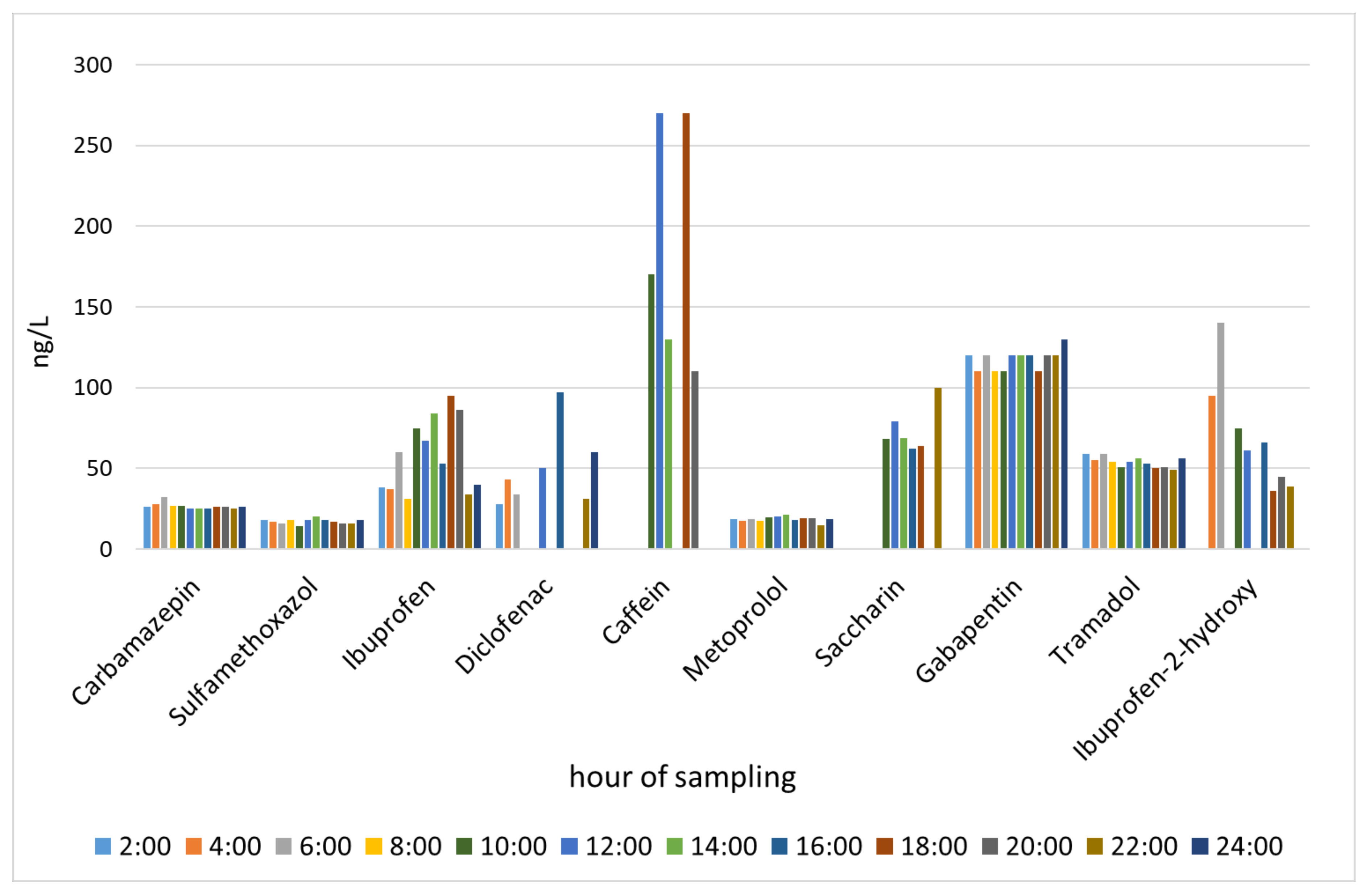PPCP Monitoring in Drinking Water Supply Systems: The Example of Káraný Waterworks in Central Bohemia
Abstract
:1. Introduction
2. Materials and Methods
2.1. Characteristics of the Káraný Pilot Site
2.2. Analytical Methods
3. Results
3.1. Source Area of PPCPs in the River Water
3.2. Changes in PPCP Concentrations in River Water between Mladá Boleslav and the Weir in Sojovice
3.3. Removal of PPCP Substances during the Production of Drinking Water Using Artificial Recharge
3.4. Removal of PPCPs during Drinking Water Production Using Bank Infiltration Technology
4. Discussion
5. Conclusions
- Raw water from the Jizera River contains a range of PPCPs in concentrations ranging from nanograms to micrograms per liter.
- The wastewater treatment plant at Mladá Boleslav significantly affects the quality of water used for production of drinking water in the Káraný waterworks. Of the 44 substances systematically detected in the river water below the wastewater treatment plant, 18 substances showed elevated content. The increase of telmisartan and iomeprol concentrations was approximately 100 ng/L, and in the case of oxypurinol, nearly 200 ng/L.
- The water discharge during flood periods significantly affects the time-related variability in PPCP content in river water. At elevated water discharges (10 m3/s), PPCP concentrations were always below the detection limit of the analytical method used.
- The time-related variability of some PPCPs in river water during 24 h demonstrates the need for a uniform time schedule for sampling.
- Acesulfame and oxypurinol were detected in concentrations exceeding 100 ng/L in purified water using artificial recharge technology. Both these substances originate from a wastewater treatment plant comprising waste water from the psychiatric hospital at Kosmonosy. Systematic occurrence of carbamazepine, sulfamethoxazole, primidone, and lamotrigine in amounts of the first tens of ng/L originated from the river water used for artificial recharge.
- Ibuprofen and gabapentin were detected at irregular time intervals in drinking water produced through artificial recharge. Ibuprofen may come from the environment of the Quaternary aquifer when the share of artificial recharge on the total balance of mixed sample is lower.
- Bank infiltration is a technology that removes PPCPs in a more effective way than artificial recharge. None of the monitored substances occurred systematically in the mixed sample. Acesulfame occurred most frequently (in 6 cases of the 31 samples analyzed), while other substances were detected three times in maximum in concentrations of only the first tens of ng/L. The occurrences of individual detected substances were not correlated.
Author Contributions
Funding
Conflicts of Interest
References
- Zhang, Z.L.; Zhou, J.L. Simultaneous determination of various pharmaceutical compounds in water by solid-phase extraction-liquid chromatography-tandem mass spectrometry. J. Chromatogr. 2007, 1154, 205–213. [Google Scholar] [CrossRef] [PubMed]
- Huerta-Fontela, M.; Galceran, M.T.; Ventura, F. Fast liquid chromatography-quadrupole-linear ion trap mass spectrometry for the analysis of pharmaceuticals and hormones in water resources. J. Chromatogr. 2010, 1217, 4212–4222. [Google Scholar] [CrossRef] [PubMed]
- Ferrer, I.; Thurman, E.M. Analysis of 100 pharmaceuticals and their degradates in water samples by liquid chromatography/quadrupole time-of-flight mass spectrometry. J. Chromatogr. 2012, 1259, 148–157. [Google Scholar] [CrossRef] [PubMed]
- Richardson, S.D. Environmental mass spectrometry: Emerging contaminants and current issues. Anal. Chem. 2006, 78, 4021–4045. [Google Scholar] [CrossRef] [PubMed]
- Rozman, D.; Hrkal, Z.; Eckhardt, P.; Novotna, E.; Boukalova, Z. Pharmaceuticals in groundwaters: A case study of the psychiatric hospital at Horní Beřkovice, Czech Republic. Environ. Earth Sci. 2015, 73, 3775–3784. [Google Scholar] [CrossRef]
- Rozman, D.; Hrkal, Z.; Váňa, M.; Vymazal, J.; Boukalová, Z. Occurrence of Pharmaceuticals in Wastewater and Their Interaction with Shallow Aquifers: A Case Study of Horní Beřkovice, Czech Republic. Water 2017, 9, 218. [Google Scholar] [CrossRef]
- Chena, Y.; Vymazal, J.; Březinová, T.; Koželuch, M.; Kulec, L.; Huangd, J.; Chena, Z. Occurrence, removal and environmental risk assessment of pharmaceuticals and personal care products in rural wastewater treatment wetlands. Sci. Total Environ. 2016, 566–567, 1660–1669. [Google Scholar] [CrossRef] [PubMed]
- Vymazal, J.; Dvořáková Březinová, T. Removal of saccharin from municipal sewage: The first results from constructed wetlands. Chem. Eng. J. 2016, 306, 1067–1070. [Google Scholar] [CrossRef]
- Vymazal, J.; Dvořáková Březinová, T.; Koželuh, M.; Kuleb, L. Occurrence and removal of pharmaceuticals in four full-scale constructed wetlands in the Czech Republic—The first year of monitoring. Ecol. Eng. 2017, 98, 354–364. [Google Scholar] [CrossRef]
- Lubliner, B.; Redding, M.; Ragsdale, D. Pharmaceuticals and Personal Care Products in Municipal Wastewater and Their Removal by Nutrient Treatment Technologies; Washington State Department of Ecology: Olympia, WA, USA, 2010; Volume 230.
- Kasprzyk-Hordern, B.; Dinsdale, R.M.; Guwy, A.J. The removal of pharmaceuticals, personal care products, endocrine disruptors and illicit drugs during wastewater treatment and its impact on the quality of receiving waters. Water Res. 2009, 43, 363–380. [Google Scholar] [CrossRef] [PubMed]
- Ternes, T.A. Occurrence of drugs in German sewage treatment plants and rivers. Water Res. 1998, 32, 3245–3260. [Google Scholar] [CrossRef]
- Tauxe-Wuersch, A.; De Alencastro, L.F.; Grandjean, D.; Tarradellas, J. Occurrence of several acidic drugs in sewage treatment plants in Switzerland and risk assessment. Water Res. 2005, 39, 1761–1772. [Google Scholar] [CrossRef] [PubMed]
- Rodriguez, E.; Campinas, M.; Acero, J.L. Investigating PPCP Removal from Wastewater by Powdered Activated Carbon/Ultrafiltration. Water Air Soil Pollut. 2016, 227, 177. [Google Scholar] [CrossRef]
- Rivera-Utrilla, J.; Sanchez-Polo, M.; Ferro-Garcia, M.A.; Prados-Joya, G.; Ocampo-Perez, R. Pharmaceuticals as emerging contaminants and their removal from water. A review. Chemosphere 2013, 93, 1268–1287. [Google Scholar] [CrossRef] [PubMed]
- Jones, O.A.; Lester, J.N.; Voulvoulis, N. Pharmaceuticals: A threat to drinking water? Trends Biotechnol. 2005, 23, 163–167. [Google Scholar] [CrossRef] [PubMed]
- Stackelberg, P.E.; Gibs, J.; Furlong, E.T.; Meyer, M.T.; Zaugg, S.D.; Lippincott, R.L. Efficiency of conventional drinking-water-treatment processes in removal of pharmaceuticals and other organic compounds. Sci. Total Environ. 2007, 377, 255–272. [Google Scholar] [CrossRef] [PubMed]
- Kožíšek, F.; Pomykačová, I.; Jeligová, H.; Čadek, V.; Svobodova, V. Survey of human pharmaceuticals in drinking water in the Czech Republic. J. Water Health 2013, 11, 84–97. [Google Scholar] [CrossRef] [PubMed]
- Godoy, A.A.; Kummrow, F.; Pamplin, P.A.Z. Occurrence, ecotoxicological effects and risk assessment of antihypertensive pharmaceutical residues in the aquatic environment—A review. Chemosphere 2015, 138, 281–291. [Google Scholar] [CrossRef] [PubMed]
- Commission Implementation Decision (EU) 2015/495 of 2015 Establishing a watch list of substances for Union-wide monitoring in the field of water policy pursuant to Directive 2008/105/EC of the European Parliament and of the Council. Off. J. Eur. Union 2015, 56, L 78/40.
- Jedlička, B.; Kněžek, M. Artificial recharge. Hydrogeol. Roč 1968, 1, 131–148. (in Czech). [Google Scholar]
- Skalický, M. Artificial recharge of the Káraný site as a tool for solving the lack of groundwater for water use (in Czech). In Proceedings of the “Groundwater in Water Treatment 2015”, Pardubice, Czech Republic, 1–2 April 2015. [Google Scholar]
- Milický, M. Káraný Waterwork—Evaluation of the Development of the Groundwater Resources and Quality of Groundwater during the Hydrological Year 2017, Optimization of the Operation of the Artificial Infiltration Complex, Optimization of the Operation of Sources of Bank Infiltration with Increased Nitrate Content (in Czech); Final Rapport; PROGEO Company: Roztoky, Czech Republic, 2018. [Google Scholar]









| Well | |||||||
|---|---|---|---|---|---|---|---|
| Name of Monitoring Well | SO 1032 | HS1 | HS2 | HS3 | HS4 | HS5 | |
| PPCP | Unit | ||||||
| Bisfenol A | ng/L | 63.4 | <50.0 | 217 | <50.0 | <50.0 | 85.3 |
| Ibuprofen | ng/L | <20.0 | <20.0 | 34.8 | 25.9 | <20.0 | <20.0 |
| Caffein | ng/L | <100 | <100 | 186 | 128 | <100 | <100 |
| Ketoprofen | ng/L | <10.0 | <10.0 | 24.5 | 53.1 | 20.2 | <10.0 |
| Saccharin | ng/L | <50.0 | <50.0 | 51.5 | <50.0 | <50.0 | 81.9 |
| Paracetamol | ng/L | 10.4 | <10.0 | <10.0 | <10.0 | <10.0 | 138 |
| Paraxanthine | ng/L | <100 | <100 | 114 | 172 | <100 | <100 |
| Bisfenol S | ng/L | <50.0 | <50.0 | 4570 | 565 | <50.0 | 62.8 |
| Sampling Data | |||||||||||||||
|---|---|---|---|---|---|---|---|---|---|---|---|---|---|---|---|
| PPCP | Unit | 16.1.2017 | 19.5.2017 | 20.6.2017 | 27.6.2017 | 11.7.2017 | 24.8.2017 | 5.10.2017 | 2.11.2017 | 12.12.2017 | 11.4.2018 | 22.5.2018 | 27.6.2018 | 10.7.2018 | 14.8.2018 |
| Ibuprofen | ng/L | 54 | 31 | ||||||||||||
| Diclofenac | ng/L | 31 | |||||||||||||
| Caffein | ng/L | 140 | 230 | 148 | |||||||||||
| Chloramphenicol | ng/L | 32 | |||||||||||||
| Saccharin | ng/L | 65 | |||||||||||||
| Gabapentin | ng/L | 11 | |||||||||||||
| Paracetamol | ng/L | 10 | 16 | ||||||||||||
| Clarithromycin | ng/L | ||||||||||||||
| Roxithromycin | ng/L | ||||||||||||||
| Paraxanthine | ng/L | 141 | |||||||||||||
| Acesulfam | ng/L | 57 | 64 | 58 | 60 | 60 | 59 | ||||||||
| Oxypurinol | ng/L | 72 | 50 | 61 | |||||||||||
| Primidone | ng/L | 11 | |||||||||||||
© 2018 by the authors. Licensee MDPI, Basel, Switzerland. This article is an open access article distributed under the terms and conditions of the Creative Commons Attribution (CC BY) license (http://creativecommons.org/licenses/by/4.0/).
Share and Cite
Hrkal, Z.; Eckhardt, P.; Hrabánková, A.; Novotná, E.; Rozman, D. PPCP Monitoring in Drinking Water Supply Systems: The Example of Káraný Waterworks in Central Bohemia. Water 2018, 10, 1852. https://doi.org/10.3390/w10121852
Hrkal Z, Eckhardt P, Hrabánková A, Novotná E, Rozman D. PPCP Monitoring in Drinking Water Supply Systems: The Example of Káraný Waterworks in Central Bohemia. Water. 2018; 10(12):1852. https://doi.org/10.3390/w10121852
Chicago/Turabian StyleHrkal, Zbyněk, Pavel Eckhardt, Anna Hrabánková, Eva Novotná, and David Rozman. 2018. "PPCP Monitoring in Drinking Water Supply Systems: The Example of Káraný Waterworks in Central Bohemia" Water 10, no. 12: 1852. https://doi.org/10.3390/w10121852
APA StyleHrkal, Z., Eckhardt, P., Hrabánková, A., Novotná, E., & Rozman, D. (2018). PPCP Monitoring in Drinking Water Supply Systems: The Example of Káraný Waterworks in Central Bohemia. Water, 10(12), 1852. https://doi.org/10.3390/w10121852





